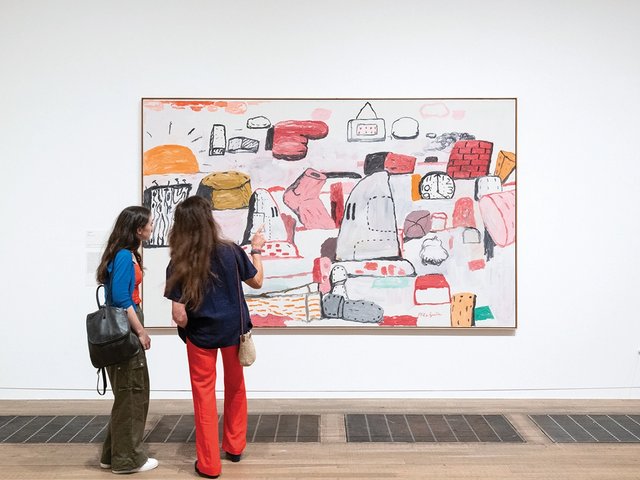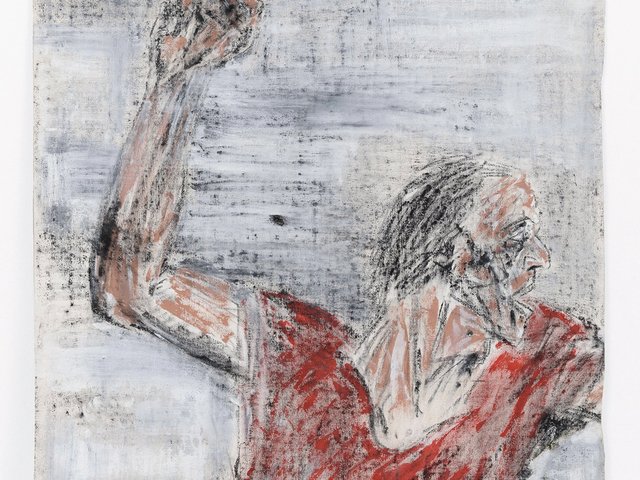Leon Golub once said, “The role of the museum needs considerable clarification and redefinition in our society,…..and its obligation towards tradition [needs to be] separated from prestige collecting.”
That was back in 1948, when Golub was 26. At 79, bald and stooped, he is still fighting that battle as hard as ever, even though a younger generation of artists and critics is barely aware of him.
Few “unknown” artists can point to two retrospectives touring museums now. The career overview, “Leon Golub: echoes of the Real” until 19 August at the Brooklyn Museum of Art has toured Dublin, London and Buffalo. “Leon Golub: while the crime is blazing: paintings and drawings 1994-99” is at the MacDonald Stewart Art Centre in Guelph, Ontario until 10 June before a five-city run ends.
Golub has outlived the rise and fall of Abstract Expressionism, Pop Art, Fluxus, Minimalism, Neo-Expressionism and the decree that painting is dead. “That's happened a few times,” he smiled, “and I also outlived the death of art.”
The painter still works with the same process he has used for decades. He sketches an image taken from a photograph or photographs, places layers of acrylic paint on it, then covers it with linoleum, which he scrapes off. “Out of that emerge the forms. I've used that to portray mostly men in confrontational or tense circumstances,” he explained.
His archive contains some 120,000 photographs. Golub has not taken any of them. “People bring them to me, or when I’m in Paris, instead of going to the Louvre, I buy books of photographs and cut them up to keep two or three that I like. They say we're 90% water; well, we're 90% photographs,” he said.
Golub has worked against the trend for most of the last six decades. In the late 1940s he chose not to make abstract paintings. "It has to connect at some level. Abstraction just didn't hit me where I was. I am still not that reactive to abstract painting but I've learned how to be nice. I don't necessarily always go out of my way to attack abstraction But I don't get excited if I see a Mondrian, as some people do. If I encounter a Barnett Newman, I encounter a wall of colour. It's impenetrable to me. It's a flat colour and all the transcendental things that are ascribed to it, I don't see. I'm interested in how figures penetrate space, how they function within the space in which events take place. And to do that you need a non-abstract space," he said.
“I'm interested in painting, too, but everything's a subject,” Golub maintained. “If you paint a monochromatic painting, then your subject is a monochromatic painting. You're obsessed with your subject. They can't claim total purity in that. So it's all red—that doesn't mean that they don't have the subject red in their head, to paint.”
There are still nasal echoes of Chicago in Golub's booming voice, but he has lived in New York since 1964 and shared the same space a block from Washington Square with his wife, the artist Nancy Spero.
On the walls during a recent visit were two unframed works, the completed “Bite Your Tongue” and the unfinished “Bite Your Tongue II.” The finished picture had a decapitated head on a cross-like scaffold with a cigarette in the dead man's lips (an image from the Vietnam War) and a menacing dog below it. The words "Loyalty Discipline Renewal," scrawled as a warning, are followed by "Bite Your Tongue."
Dogs abound in Golub’s work (so do sphinxes). They are not the loyal companions that protect St Roc and other devout souls in Christian art. "Dogs are omnipresent. Dogs are everywhere," said Golub, noting that the white squares in many of his paintings are sections where dogs have been painted over. "They're our alter-egos. They're roaming the streets. They represent our most primitive impulses at times," he said. "I mean, I don't paint lapdogs. The dog reference permits me to put in something that's unruly, something that's not quite controlled in our everyday civic attitudes."
Golub's paintings these days explore what he calls "the underbelly," a realm of brusque, cruel irrationality. Figures are often human reptiles. For him, the term "Dyonisiac", the title of a 1999 painting of a dismembered figure, suggests the unstoppable impulse toward violence rather than any notion of sudden pleasure.
Born in Chicago, Golub studied at the Art Institute of Chicago School, where he met Spero. Post-war Chicago was a less dismissive place than New York for figurative painters. Jean Dubuffet's stature there was high, and the Field Museum of Natural History, a vast collection of fossils, skeletons and objects of “primitive art”, was a major influence on Golub, for whom Greek art was also important. His frieze-like series of battling giants, “Gigantomachy” (1965-66), is inspired by the Altar of Zeus, now in the Pergamon Museum, Berlin.
The Vietnam War made Golub's art overtly political. As a figurative painter opposed to the war, Golub felt that he had to reflect that opposition, unlike abstract painters whose political feelings might be separate from their work. The iconic nudes in “Gigantomachy” evolved into uniformed figures, and the scrapings of paint, which Golub normally discarded, became explosions of colour in works such as “Napalm”. As the war fiercened, Golub's “Vietnam” canvases grew huge and asymmetrical. “I wanted to have a scale, equal—now this sounds moronic, maybe—to the war itself. I wanted a canvas of the world in which this was taking place.”
Those large works failed to interest many people, or to sell. In the 1970s Golub turned from mural scale to portraits of political leaders, which began with the images of photographs that he found—”smaller, calmer, more controlled, more tenacious.” He painted 150 of them in three years, with subjects ranging from Henry Kissinger to Ho Chi Minh, to Nelson Rockefeller, the rich politician whose family supported the Museum of Modern Art.
An odd choice for a painter who wanted to be in MoMA’s collection some day? “I don’t think they know that the portraits even exist—or maybe they do know,” Golub said. “What they should have done is purchase the Rockefeller portrait. That would have been the way for a true aristocrat to handle dissension”.
MoMA finally acquired its first Golub painting two years ago, a “Gigantomachy I” (1965) that was a gift from a collector. Looking at “Bite Your Tongue,” Golub conceded that his work might be a hard sell: "It has to do with one obvious thing—that not many people want to put a painting like that on their walls. Your average investment banker doesn't want to come home and see that, after a bad day at the office, or after a good day. Either way."
He also faults curators for their timidity. Only some 13 museums own his works. "What the hell are you going to do with them? There are three solutions possible: one is to say they're terrific; one is to say they're lousy, but both are very dangerous solutions. History might reverse you on either. So the best way is not to pay attention, so even if they're 20 feet long, they're not seen.”
Yet Charles Saatchi bought his work in bulk. Eli Broad, the Californian property developer, is a Golub collector. There are others, but they are a small group.
"In the 80s, I attracted a lot of attention. I think it's because Neo-Expressionism came up, and I looked like a Neo-Expressionist to a lot of people," commented Golub.
The man who resisted so many movements in art is not out to create one of his own: "I don't want to proselytise. I'm not trying to sell the idea of political art. I don't even use the term political—it's vague anyway. I just want to get to the real. What does our world look like, how does it feel, what's the world we're in? That's what I want to paint. That sounds nuts, doesn't it?"
“Echoes of the real: Leon Golub paintings, 1950-2000” (until 19 August 19), Brooklyn Museum of Art, 200 Eastern Pkwy, Brooklyn, NY 11238 Tel: +1 718 638-5000



